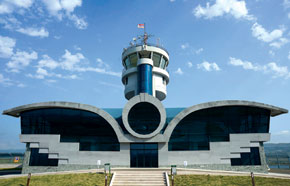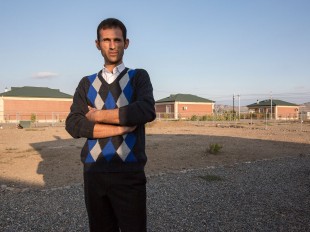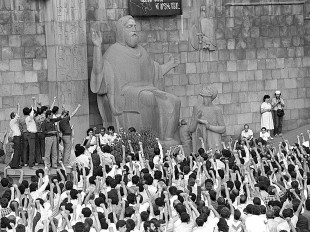 For nigh on two years the occupying authorities in the Azerbaijani territory of Nagorno-Karabakh have been promising to reopen the region’s main airport. The airport, near the town of Khojaly, closed to flights on 25 February 1992 after it was stormed by Armenian forces.
For nigh on two years the occupying authorities in the Azerbaijani territory of Nagorno-Karabakh have been promising to reopen the region’s main airport. The airport, near the town of Khojaly, closed to flights on 25 February 1992 after it was stormed by Armenian forces. The occupying authorities began to rebuild Khojaly airport in 2009, announcing that it would reopen to flights in May 2011. May came and went, as did 2011 and 2012, and the airport is still waiting for its first flight.
Contrary to international law
Azerbaijan has been opposed to the reopening of the airport from the very beginning, as it is situated in occupied Azerbaijani territory. Azerbaijani Foreign Minister Elmar Mammadyarov pointed out earlier this year that flights over occupied territory are prohibited by international law.
Raymond Benjamin, head of the UN’s civil aviation regulatory body, the ICAO, confirmed to Azerbaijani officials in April that it is inadmissible for Khojaly civil airport to be reopened in occupied territory and in a military conflict zone to boot. He said that attempts to unilaterally open Khojaly airport without Azerbaijan´s permission would be a clear violation of the ICAO Chicago Convention and international law.
Response?
The main question raised in the media is: if Armenia begins to use Khojaly airport, might civil aircraft using it be shot down?
On 17 January 2013, Azerbaijan’s Cabinet of Ministers passed Regulations on the Use of the Air Space of the Azerbaijan Republic. Most significant among the provisions is the possibility to shoot down civil aircraft that enter Azerbaijani air space without permission. According to the regulations, an aircraft violating Azerbaijani air space should first of all be asked to turn back. If it does not heed the call, attempts should be made to force it to land. If these too fail and there is no information about the presence on board of any innocent parties, then under Azerbaijani law it is possible to destroy the aircraft.
Khojaly airport has been registered by the Azerbaijan Republic with the International Civil Aviation Organization (ICAO). In the ICAO list, the airport has the code UB13 – all airports with codes beginning UB belong to Azerbaijan. Armenia has changed the name of the airport and now calls it Stepanakert International Airport, although it is in fact much closer to Khojaly, and its Azerbaijani registration remains.
Azerbaijan is fully within its rights to oppose the flights under both its own regulations and the provisions of the Chicago Convention on International Civil Aviation, adopted in 1944. The Chicago Convention says that every state has complete and exclusive sovereignty over the airspace above its territory and no scheduled international air service may be operated over or into the territory of a contracting state, except with the special permission or authorization of that state. If required by the state, any foreign civil aircraft should land.
No use of arms against civil aircraft
Following two tragic incidents in which civil aircraft were brought down and hundreds of passengers killed – in 1983, Soviet air forces shot down a South Korean B-747 passenger plane and in 1988 the USS Vincennes brought down an Iranian Airbus – the ICAO declared at an extraordinary meeting that the non-use of arms against civil aircraft should be a fundamental principle for every state. This was enshrined in 1998 in amendment 3bis to the Chicago Convention. The contracting States recognize that every State must refrain from resorting to the use of weapons against civil aircraft in flight and that, in case of interception, the lives of persons on board and the safety of aircraft must not be endangered.
The convention says that member states should oblige their aircraft to follow the instructions of the state in whose air space they are flying when required to leave the air space or land at an indicated airport. The captain and any other crew who violate this regulation should be subject to serious sanctions.
While criticizing the use of arms against civil aircraft, the UN Security Council has also called on member states to ensure that aircraft registered in their state respect the sovereign rights of other states. This Security Council resolution followed the shooting down of two small US planes by Cuba in 1996, as a result of which four people died. Cuba argued that the aircraft had violated their air space several times and although the appropriate US bodies had been informed about it, they had not taken any action.
Sanctions
Flights to Khojaly airport would be illegal, since Azerbaijan will not give permission for its air space to be used. This prompts two more questions: would Armenia make the flights anyway, in violation of international law, and what sanctions would they face as a result? After all, Armenia is occupying Nagorno-Karabakh in defiance of international law and four resolutions of the UN Security Council.
Any airline making flights to Khojaly might be subject to sanctions. Armenia’s national carrier, Armavia, filed for bankruptcy on 1 April, so is in no position to begin flights to Khojaly, even if it wanted to. The occupying authorities in Karabakh announced in 2011 the creation of their own airline, Artsakh Air, to operate flights between Khojaly and Yerevan. The head of their civil aviation department acknowledged in autumn 2012, however, that the airline had yet to be registered.
All aircraft that make international flights are registered under the flag of their home country and have a distinctive identification number, which includes the call sign of their home country. Aircraft IDs are carried in their transponders, a device that receives and transmits information about the aircraft to Air Traffic Control. This allows Air Traffic Control to identify any aircraft.
Any aircraft that Artsakh Air acquires will have to be registered in Armenia, as the Nagorno-Karabakh republic is not a legal state. When Azerbaijan’s objections to flights by Artsakh Air are upheld, Armenia will be obliged as a signatory to the Chicago Convention to take action against Artsakh Air.
Should Armenia take no action against aircraft registered in its territory that fly to Karabakh, Azerbaijan may complain to the ICAO about Armenia. If the complaint is upheld, all member states would have to close their air space to the airline that violated flight regulations.
Trial balloon
When flights to Khojaly airport are so clearly fraught with problems, why are Armenia and Karabakh even contemplating this venture? The Armenian leadership has said many times that if a peaceful settlement of the conflict is desired, then it is important to provide the population of Nagorno-Karabakh with air transport. It is, however, absurd to say that air transport for the 138,000 people living in rural Nagorno-Karabakh is a priority at a time when Armenia is still gripped by economic crisis and its national carrier has had to file for bankruptcy.
Armenia may well be trying to shirk responsibility for the failure to make progress in the peace negotiations, seeking to put the blame on Azerbaijan’s supposed ‘non-constructive’ position. This is the view of Azerbaijani presidential official Novruz Mammadov.
Azerbaijan considers the question of opening Khojaly airport to be Armenian provocation against the negotiating process on the settlement of the Nagorno-Karabakh conflict and against international law. Moreover, the Armenians are making these statements in order to test the response.
Matter of time?
Armenia is still talking as though flights to Karabakh are just a matter of time. Complaints to the ICAO Council about Armenia would be more likely to have a positive outcome than any use of force. The ICAO secretary-general has already made it clear that Armenia would lose that debate. If Armenia continued to allow flights to operate, then, in accordance with UN Security Council resolution No 1067 (1996), Azerbaijan would be able to take action against the aircraft. Although this action would not involve direct use of arms, it could hinder the flight. For example a fighter plane might fly in front of the aircraft, and force the plane to land.


